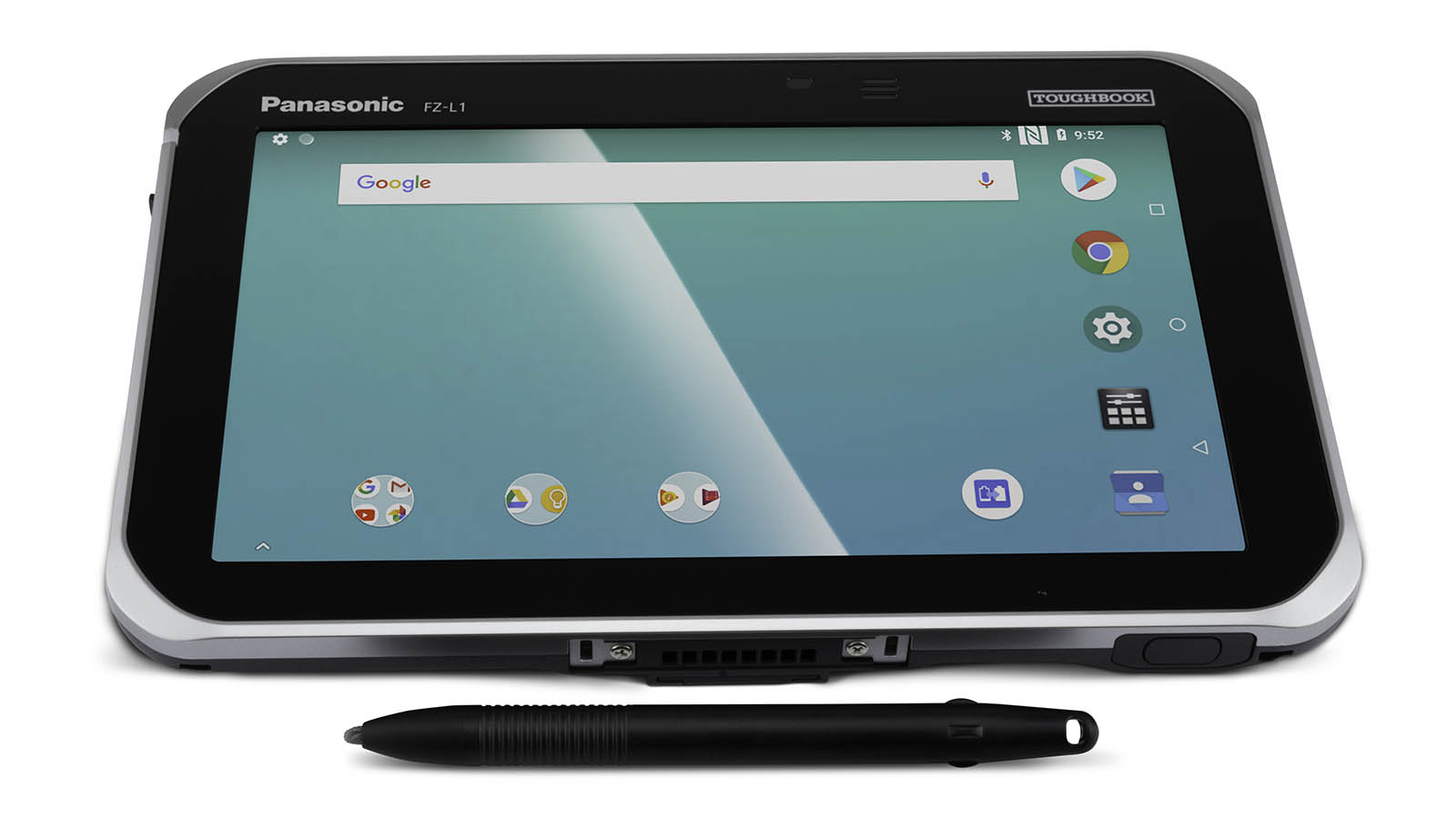Why you can trust TechRadar
Specifications
Here is the Panasonic Toughbook FZ-L1 configuration sent to TechRadar Pro for review:
CPU: Qualcomm MSM8909 (Snapdragon 210) 1.1GHz Quad Core
GPU: Adreno 304 400MHz
RAM: 2GB
Screen: 7-inch LCD 1280 x 800 touchscreen
Storage: 16GB eMMC, microSD card slot
Ports: Audio jack, microUSB 2.0, docking connector, barcode reader (optional)
Connectivity: 802.11n Wi-Fi, Bluetooth 4.2 Class 1, 4G LTE, HSPA+, UMTS, EDGE, GPRS, GSM (region dependent)
Camera: 8MP
OS: Android 8.1
Weight: 540g
Size: 203 x 18 x 132mm (W x D x H)
Battery: 3200mAh (warm swappable)
To be kind, the specification of the FZ-L1 is very basic and lacks many of the features you’d expect on a modern phone or tablet. The positive spin on this scenario is that given how long the SoC used here has been around, it should be very reliable.
By current tablet standards, it doesn’t have much power, memory or storage, although you can boost storage with a Micro SD card.
There is only one rear facing camera, but the 8MP sensor on this isn’t anything special.
Other disappointments include Wi-Fi that doesn’t offer an AC mode, there are no full-size USB ports, no USB Type-C and you can’t wirelessly charge it.
Performance
When we read the specifications and saw this tablet used the Qualcomm Snapdragon 210 MSM8909 processor, we assumed its performance would be mediocre. And testing underlined our assertions with a highlight marker.
The Snapdragon 210 is an entry-level quad-core Cortex-A7 design that Qualcomm launched back in 2015, has a maximum clock of just 1.1 GHz and a memory controller that interfaces to LPDDR2/LPDDR3 RAM up to 533MHz.
If you intend to use this device to capture data or browse web pages, then it will probably suffice, but anything that requires local processing could easily overload this platform.
Sign up to the TechRadar Pro newsletter to get all the top news, opinion, features and guidance your business needs to succeed!
Geekbench rated this system as equivalent to the Samsung Galaxy J2 and Cubot Note S on single core tests, and equal to the LG K7 for the multi-core challenge. Compute numbers are in line with the Huawei Y6 Pro and Samsung Galaxy A3.
Battery life is much the same as the 2014 era Sony Xperia Z3, and about half what you get from a Samsung Galaxy A3 (2017 version).
Most of these comparable devices are budget phones, and most are old enough to have been discontinued. The Huawei Y6 Pro is a new phone design but costs only £99 (around $125).
Some logic could be attributed to this choice if it was to reduce power consumption, providing a longer battery life.
However, we’d contest that a more modern and efficient octa-core design with variable core clocking would last longer with the same 3200 mAh battery.
To put that capacity in perspective and how the SoC can impact battery life, the Moto G7 phone costs $199, uses a Qualcomm SD632 octa-core CPU, has a 3000 mAh battery but can last over 15 hours, with a much higher resolution screen, double the RAM and four-times the storage. It can also fast charge in 15 minutes and get 9 hours of life from that.
Where Panasonic claims the single battery life of the FZ-L1 is up to 9 hours, but we didn’t get that long in our testing.
There are two takeaways from our tests; the first of them being that don’t expect this device to work as smoothly as a modern Android phone, even a cheap one.
And secondly, budget for extra batteries and a battery charger if you want any reasonable operating life away from power sockets.

Final verdict
There is a disconnect here, where Panasonic have repackaged 2015 tablet technology into a tough case and forgot that the user experience isn’t based purely on the resilience of it to abuse.
Among the low points are a mediocre screen, an entirely lack-lustre CPU and GPU combination, small memory, limited storage and Wi-Fi that lacks AC class technology.
Other than its ability to withstand wet weather, being dropped and the LTE option, it has practically nothing about it that trumps a $150 tablet.
Even the warm-swap battery feature is undermined by the lack of capacity in the batteries, making it more of a necessity than a headline feature.
When you factor in the cost of the device, extra batteries, the cradle, cradle charger, five-day Battery charger (for five batteries) and hand strap, you could easily spend $2,500 or more on this device and accessories for a single deployment.
When you compare this with other tough tablets, it might be cheaper than the insanely expensive Dell Latitude 7212 (£2,042, around $2,600), but it is triple the cost of the much higher specification HP ElitePad G2 1000 and Samsung Galaxy Tab Active 2.
And, there are dozens of powerful Chinese phablets that cost $300-400 and offer even greater protection against water and dust and have 10000 mAh batteries.
The technology inside this machine does not come close to justifying the cost, even if you can drop it in frustration and expect it to keep working.
- We've also highlighted the best rugged tablets
Mark is an expert on 3D printers, drones and phones. He also covers storage, including SSDs, NAS drives and portable hard drives. He started writing in 1986 and has contributed to MicroMart, PC Format, 3D World, among others.

